|
186 years 1830 -
2016 |
The Fleet in 2016
%202010.jpg)
Ben-my-Chree
(6) 2010 after her refit in 2009
%202010.jpg)
Super
Fastcraft Manannan (1)
The Isle of Man Steam Packet Company History
The Isle of Man Steam Packet Company is the oldest continually operating
passenger shipping company in the world, having began operations in 1830.
Prior to 1830, there were other shipping companies serving the Isle of Man,
before the Steam Packet Company was formed. The smuggling trade (causing
considerable loss to the British Revenue) led to the Crown purchasing the Isle
of Man from the Atholl family in 1765 and the Redcoats moved in. Two years
after this, Westminster organized a weekly packet boat service between Douglas
and Whitehaven, thereby providing a lifeline to the Garrison on the Isle of
Man.
Irregular crossings
Sea crossings between the Isle of Man
and England could be terrible and ships could be driven back to Cumberland
after days at sea and there were times during the winter months when the Isle
of Man was cut off for weeks. The sailings carried too many of the Isle of
Man’s young men away, who wanted to escape the harshness of Island life. But,
many people arrived on the Isle of Man – some adventurous wanting change, some
merely escaping creditors (debts in the United Kingdom could not be enforced on
the Isle of Man).
Population growth
The Isle of Man’s population grew between 1767 when the first regular
sailings started from 20,000 to around 40,000 by the time the Isle of Man Steam
Packet Company was formed.
From the beginning of the 19th Century many things happened to open the Isle of
Man to an increasing amount of traffic. Work on the Red Pier at Douglas
commenced in 1793 and was completed in 1801 at the cost of £25,000 to the
British Treasury.
The first Engine ships
In 1815, sail was giving way to the first engine. The first steamer called
at the Isle of Man on its voyage from the Clyde to Liverpool and in 1819 James
Little opened up the first steam ship service to the Isle of Man using it as a
port of call between Liverpool and Greenock. The first class fare was 17
shillings and 6 pence from the Isle of Man to Liverpool including provisions
and steward’s fees, with second class without provisions costing 9 shillings
and 6 pence. The journey between Douglas and Liverpool first took 10 hours,
later reduced to 9 hours and was a seasonable trade with no winter services.
More competition on the Irish Sea
get the support Competition arrived with the St. George Steam
Packet Company of Liverpool, commencing a service between Liverpool and Glasgow
in 1822, using a vessel called the St. George and calling at Douglas. The
locals began to feel it was essential that they should have their own dedicated
sea service. In 1826, a Manxman named Cosnahan living in Liverpool took over a
new steamer called Victory, put her on the Douglas-Liverpool route for 2 months
and then offered to syndicate shares in this enterprise. He failed to he had
expected, no doubt he was disappointed. His family came from the Vicar of
Santon and the family had produced a number of Manx lawyers and clerics.
A need for stability
Soon the Manx people started to feel that they deserved their own dedicated
service and preparations began to form a suitable company. A meeting was held
at Dixon and Steele Sale Rooms at Douglas Harbour on December 17th, 1829 during
which a committee was appointed charged with finding out the cost of a Steam
Packet and £4,500 was immediately subscribed from the floor. The committee was
set the task of raising the capital to £6,000 and on June 30th 1830 the Isle of
Man Steam Packet Company was born, although it was actually called the Mona’s
Isle Company at that time after the Company’s first vessel of the same name.
The Steam Packet Company’s war record
No review of the Company’s history would be complete without reference to
its distinguished war record. Our vessels and many of our crews were actively involved
in both the 1st and 2nd World War, acquitting themselves with honour in both
instances. The King Orry for example, which was attached to the British Grand
Fleet, had the distinction of leading the German Fleet into Scapa Flow at the
end of the First World War.
The Great War
During the Great War, 11 out of a total of 15 Steam Packet Company vessels
were requisitioned by the Admiralty, 4 of which were lost, 3 retained by the
Government and 4 returned to service some 4 years later.
One particular vessel worthy of mentioning is the Manxman as she is believed to
have been one of the first (if not the very first) vessels to be converted to
an aircraft carrier, to launch Sopwith Pup single-seater planes, and in doing
so made a significant contribution to nautical and aviation history.
The 2nd World War
The 2nd World War saw the Steam Packet ships employed on war service once
again. This time, having rebuilt the fleet to 16 vessels, it had its best 10
ships commandeered for active duty – 4 of which were sadly to be lost. Dunkirk
was perhaps the Company’s finest hour, with the Mona’s Isle being the first
vessel to leave Dover for Dunkirk and the first to complete the round trip
during the evacuation. Eight company ships took part in the historic mission, rescuing
a grand total of 24,699 British Troops from certain death (as a matter of
interest, this means that 1 in 14 lives saved during the Dunkirk evacuations
was brought by an Isle of Man Steam Packet Company vessel).
Happier times
Fortunately there have been happier times since, with the company owning
some 72 vessels in total from its inception to the present day. We saw busy
summer seasons during which Douglas became a fashionable resort for tourists
from England aided further by the introduction of car ferries, starting with
the Manx Maid in 1962.
The Isle of Man TT Races
And of course, a very special mention is due for the continued success of
the Isle of Man T.T. Race Festival which takes place late May/early June each
year and celebrated its centenary in 2007. During the TT race fortnight, the
Isle of Man Steam Packet Company carries around 35,000 passengers and around
10,500 motorbikes on over 200 sailings.
Current services
Today we operate regular ferry (and fast ferry) services which connect the
Isle of Man to Heysham, Liverpool, Belfast and Dublin. Those who reminisce about the past are often surprised to learn that we have more passenger
sailings now than at any time in the past 50 years.
New fast craft ferries
We offer the latest fast craft ferry services. The first SeaCat Isle of Man
crossing was from Fleetwood on June 28th, 1994 (taking just 94 minutes). There
are services to Liverpool, Dublin and Belfast with crossing times of 2
hours 45 minutes to Liverpool and just slightly longer to Ireland.
Friday 22nd of May 2009 saw the first sailing of the latest addition to the
fleet, Manannan. The 96-metre catamaran, the largest of her type on the Irish
Sea, had undergone a complete refurbishment. The extensive work included
the construction of completely new aft accommodation and a much enlarged sky
lounge on the top deck, both of which have contributed to the vessel’s
increased seating capacity of more than 800 passengers.
For a more leisurely cruise across the Irish Sea, we offer the Ben-my-Chree
which operates a twice daily conventional ferry service between Heysham and
Douglas.
A Nation's Lifeline
We carry around 600,000 passengers annually and 170,000 cars and
motorcycles. This represents an increase in passenger traffic of around 35% and
50% in vehicle traffic since 1996 not a bad performance given the increased
competition from airlines servicing the Isle of Man.
Best deals online
Around 80% of our passengers now benefit from our special offer fares with most
of our customers now choosing to book online via this website for the best
fares.
Further information acknowlegments to the steam-packet for
photos and information from their web-site.
**********************************************************************
For fares and route information passengers should log
onto http://www.steam-packet.com/
The
Steam Packet Company, the Isle of Man’s trusted carrier since 1830.
Issued
13/03/07 acknowledgement to the Isle of Man Steam-Packet
For further enquiries please contact the Steam Packet Company
Updated 17th February 2015
***********************************************************
The following three photos are from Web-sites “ Ships of
Man” Steam-packet and “Merseyside shipping “: acknowledgements to them
Ben-my-Chree
( 6 )
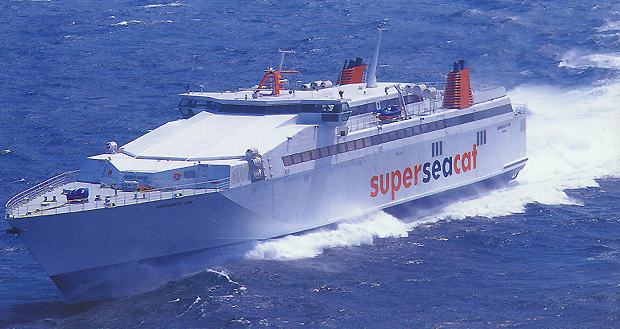
Superseacat Two
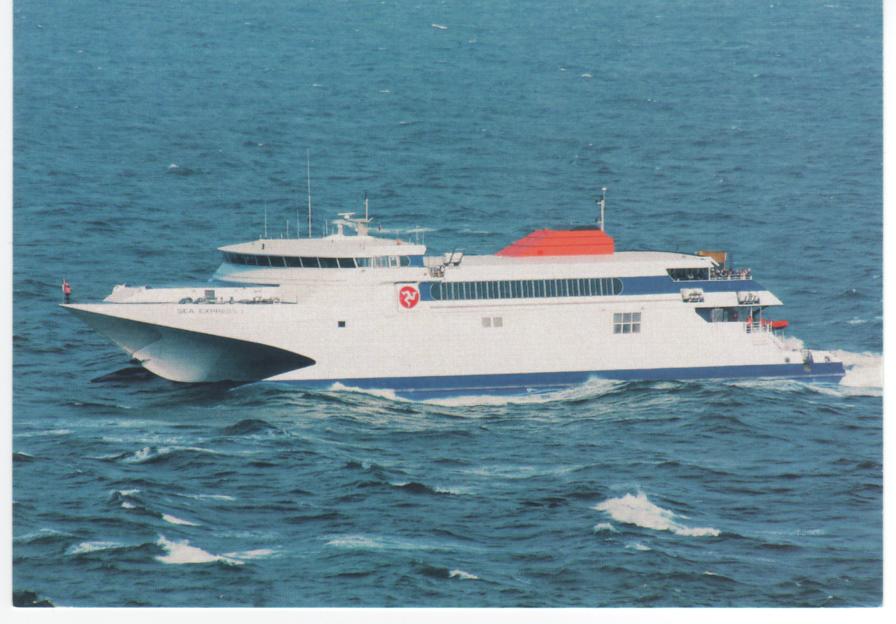
Sea Express 1
In 2005 Steam
Packet fleet consisted of the Ben-my-Chree, Sea Express 1 (ex Seacat Isle of
Man) and the Superseacat Two which was on long term charter from Sea
Containers. The future of Sea Express 1 is uncertain. She is being
prepared as we speak for further service but it is not known if she will revert
to her old name. Sea Express 1 was of course the name given to her when
she was chartered this year to the ill fated Irish Sea Express Ltd for their Liverpool
to Dublin service.
Rapide has not been on the Irish Sea since 2002 when she
served the Troon to Belfast route. She was last with the Steam Packet in 2001.
More recently she has been on the Dover -Calais service but that also has been
withdrawn by her owners, Sea Containers.
Acknowledements to the Isle of Man
Steam-Packet 20th December
2005 . & Ships of Mann February 2009
********************************************************************
Isle
of Man Steam Packet in 2001
The Isle of Man Steam Packet Company, was founded in
1830 and has provided regular crossings between the mainland England and the
Island ever since. In 2000, the Company, celebrated 170 years of continuous
operations and that year was marked by the 25th anniversary of entry
into service of the ferry Lady of Mann she went on to serve another four years.
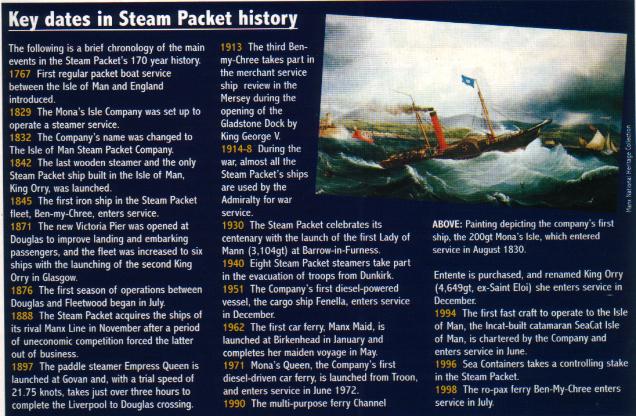
In July 1998 the
Steam Packet’s newest ship began operations on the Douglas to Heysham route.
The vessel, Ben-my-Chree the sixth so named, is also the largest ship the
company has ever operated. The ship operates four trips a day, two in each
direction, every day of the year except Christmas Day, to provide the Isle of
Man with an essential and reliable mainland link.
Ben-my-Chree is based on the standard design for a flexible-pax ferry and can be
operated as a pure freight ferry or as a combined car/passenger ferry. The
vessel features a total trailer lane capacity of approximately 1,235m but is
used by the Steam Packet for freight, cars and passengers. The vessel is of
all-welded steel construction with a bulbous bow and transom stern. Double
bottom sections are arranged between fore and aft bulkheads Vehicles can be
accommodated on Decks. 3 and 5. Access to Deck 3 is provided by a stern
ramp/door and from Deck 3 to Deck.5 by means of a hoistable ramp.
Particulars – Ben-my-Chree
Built 1998 Van der Giessen de Noord, Netherlands,
yard no.971
Tonnage 4,168 dwt, 12,504 gt, 3,751nrt
Dimensions Length 125.2m, breadth 23.4rn, design
draught 5m
Capacity 395 passengers, 20, 4-berth cabins, 80
persons, 3 decks, 303 cars
Complement 15 crew
Machinery 2 MaK 9M32 medium-speed diesels, 4,32OkW,
two bow thrusters of 900kW each, speed 19 knots
Route Heysham-Douglas
Flag, Isle of Man
The vessel can
carry up to 500 passengers in day accommodation on short voyages, but on the
Irish Sea the Steam Packet tries not to exceed 350 passengers per crossing to
ensure an adequate level of comfort.
Ben-my-Chree is powered by, two MaK medium-speed, non-reversible diesel engines, each
having a maximum continuous rating of 4,32OkW at 600rpm. Each main engine
drives a propeller via a Renk reduction gearbox. Electric power comes from
three 515kW auxiliary driven alternators, two 1,16OkW driven alternators and
one 24OkW emergency alternator set. During manoeuvring, electric power for the
bow thrusters is derived from the two auxiliary alternators.
EFFICIENT OPERATION
Ben-my-Chree
is a modern ro-pax ferry, which
has given smooth and efficient operation since entering service. Built to serve
a different age and market from the side-loading car ferries of which Lady
of Mann was
the last example, she rarely runs late except when caught in severe weather in
the Irish Sea. She has achieved a sailing performance of some 97 per cent since
being introduced onto the route, and sailings are rarely cancelled. Although a
force 9/10 gale would not necessarily result in a cancelled sailing, crossing
in such conditions is uncomfortable for both passengers and crew, while the
berthing procedure at either Douglas or Heysham in severe weather can be
difficult and possibly dangerous.
When leaving
port, once loading of passengers and vehicles is complete, the Captain is
informed that the bow doors are secure and the vessel is ready for sailing. The
usual checks to radio, radar, navigation equipment and other machinery then
take place before the vessel sets out. During the crossing, a minimum of two
crew have to be on the bridge.
Douglas and
Liverpool, and each port has its own idiosyncrasies. For example, at Heysham,
because the port is becoming increasingly busy, it is important that the ship
arrives on time so that her scheduled slot is available. and knows how much
room to allow when turning the ship, and swings her round onto the berth ready
for unloading with a practised case.
While some may
argue that Ben-my-Chree does not
have the character or graceful lines of her predecessors i.e.the Lady of
Mann her reliability, capacity and speed have brought a new
dimension to crossings to the Isle of Man and she has many more years of
regular service ahead.
The above article and photographs supplied by the “Ships Monthly”
magazine with acknowledgements in 2001
Latest
update 6th January 2014
Classic Packets of the
Past – Part 1
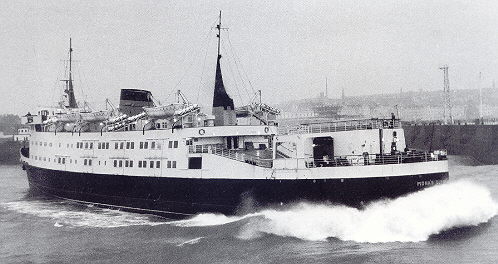
Above photo: acknowledgements to Stan Basnett and Steam-Packet Co:
for photo & information
Monas
Queen 5 official #
307621 steel twin-screw steamer 10 cyl. Piestick diesel motor ship, built Ailsa
shipbuilding Co: Ltd. Troon; yard #533 UK. Gross Tonnage 2998 Speed 21 knots,
overall length 104. 45m. Breadth 16. 74 m. launched 22 Dec 1972 cost
£2,100,000 final voyage 3 September
1990. She was sold to a Manila company and renamed Mary the Queen.
Acknowledgements to Steam-Packet Co: for following photographs and
information
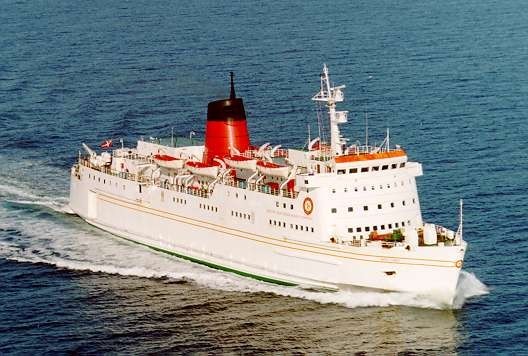
King
Orry 5 ex Channel “Entente” steel twin screw
Pielstick diesel motor ship, built in Italy gross tonnage 4649 speed 19 knots
length 114. 59 m breadth 18. 62 m,
launched 26 February 1972 cost £4.15 million acquired by I of Man SP Co 14
February 1990 renamed King Orry 1990 was in service till the new Ben-my-Chree
came into service.
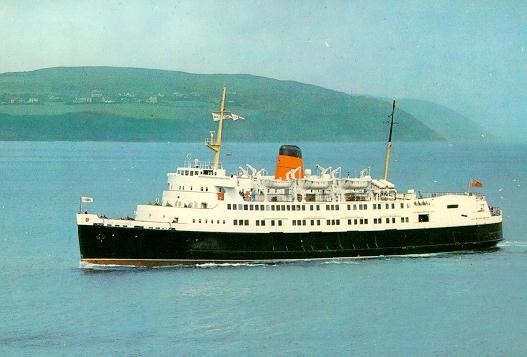
Ben-my-Chree
5 official # 186355 steel twin-screw steamer
geared turbines built and engined Cammell Laird & Co. Ltd Birkenhead UK,
yard # 1320. Gross Tonnage 2762 Speed 21. 5 knots, overall length 104. 83m.
Breadth 16. 13 m. launched 10 Dec 1965 cost £1,400,000 maiden voyage 12 May
1966. Final voyage 19 September 1984.
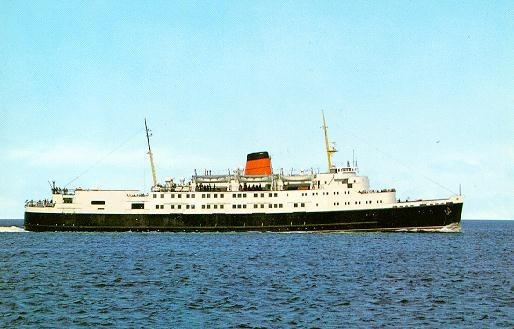
Manxmaid
2 official # 186352
steel twin-screw steamer geared turbines built and engined Cammell Laird &
Co. Ltd Birkenhead UK, yard # 1303.
Gross Tonnage 2724 Speed 21. 5 knots, overall length 104. 83m. Breadth 16. 16
m. launched 23 Jan. 1962 cost £1,087,000 maiden voyage 23 May 1962. Final
voyage 9 September 1984.
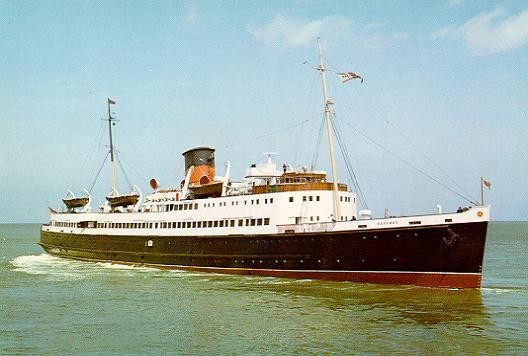
Manxman
2 official # 186349
steel twin-screw steamer geared turbines built and engined at Cammell Laird
& Co. Ltd Birkenhead UK, yard #
1259. Gross Tonnage 2495 Speed 21. 5 knots, overall length 105. 11m. Breadth
15. 24 m. launched 8 Feb 1955 cost £847,000 maiden voyage 21 May 1955. Final
voyage 4 September 1982.
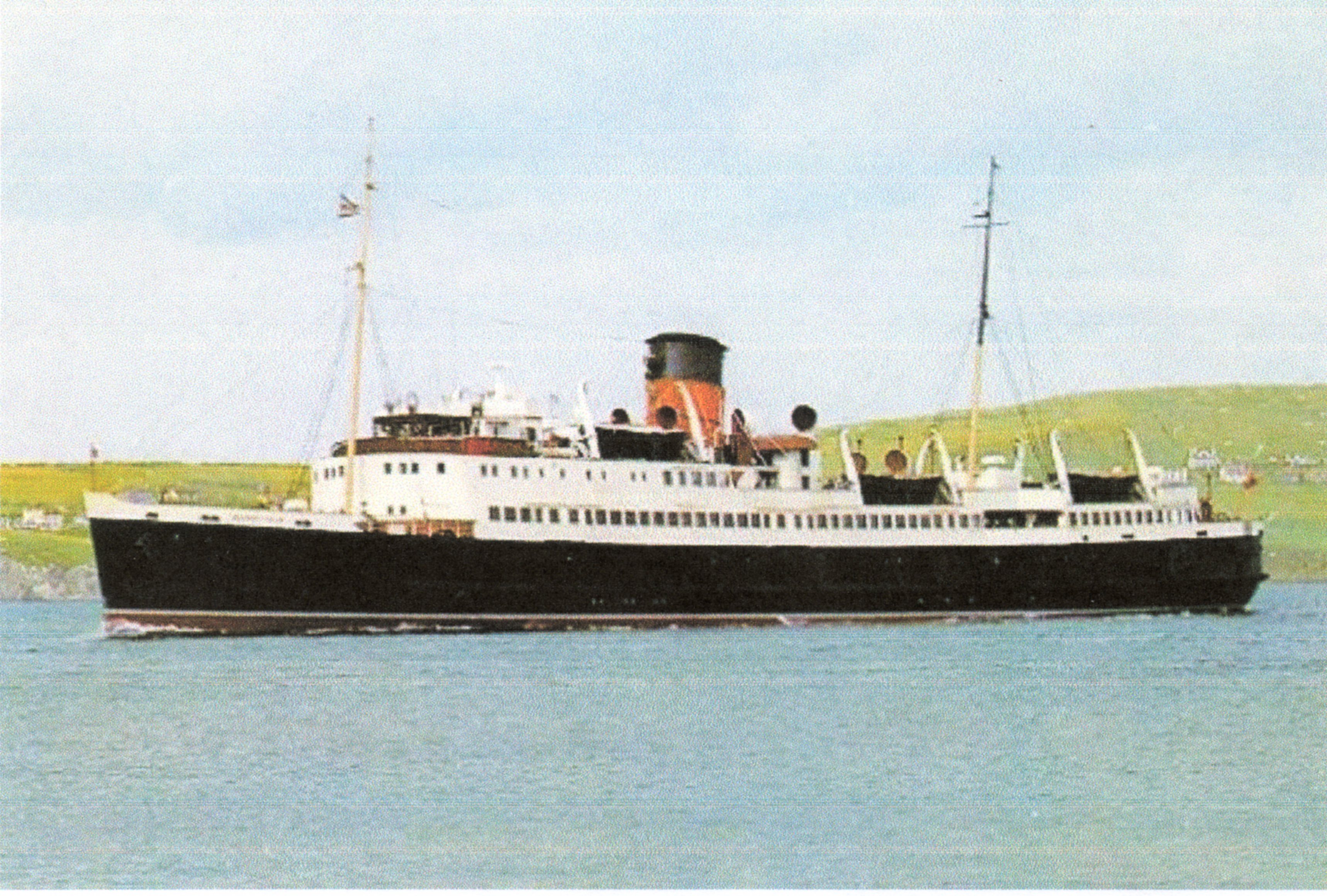
Monas
Isle 5 official # 165288 steel twin-screw
steamer geared turbines built and engined at Cammell Laird & Co. Ltd Birkenhead
UK, yard # 1209. Gross Tonnage 2491
Speed 21. 5 knots, overall length 105. 16m. Breadth 14.38 m. launched 12 Oct.
1950 cost £570,000 maiden voyage 22 March 1951. Final voyage 27 Aug 1980.
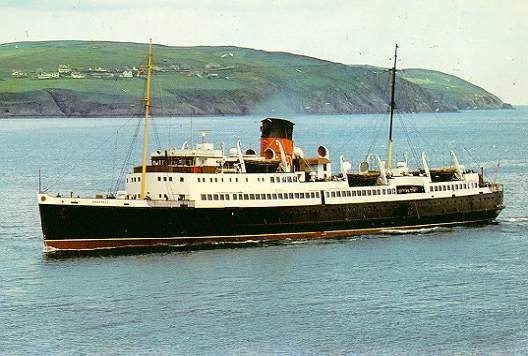
Snaefell
5 official # 165287 steel twin-screw steamer geared turbines
built and engined at Cammell Laird & Co. Ltd Birkenhead UK, yard # 1192. Gross Tonnage 2489 Speed 21. 5 knots,
overall length 105. 11m. Breadth 14.38 m. launched 11march 1948 cost £504,448
maiden voyage 24 July 1948. Final voyage 29 Aug 1977.
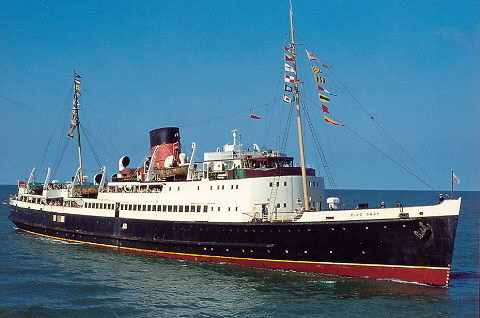
King
Orry 4 official # 165282 steel twin-screw
steamer geared turbines built and engined at Cammell Laird & Co. Ltd
Birkenhead UK. yard # 1169. Gross
Tonnage 2485 Speed 21. 5 knots, overall length 105. 19m. Breadth 14.38 m.
launched 22 Nov. 1945 cost £402,095 maiden voyage 18 Jan. 1946. Final voyage 31
Aug 1975.
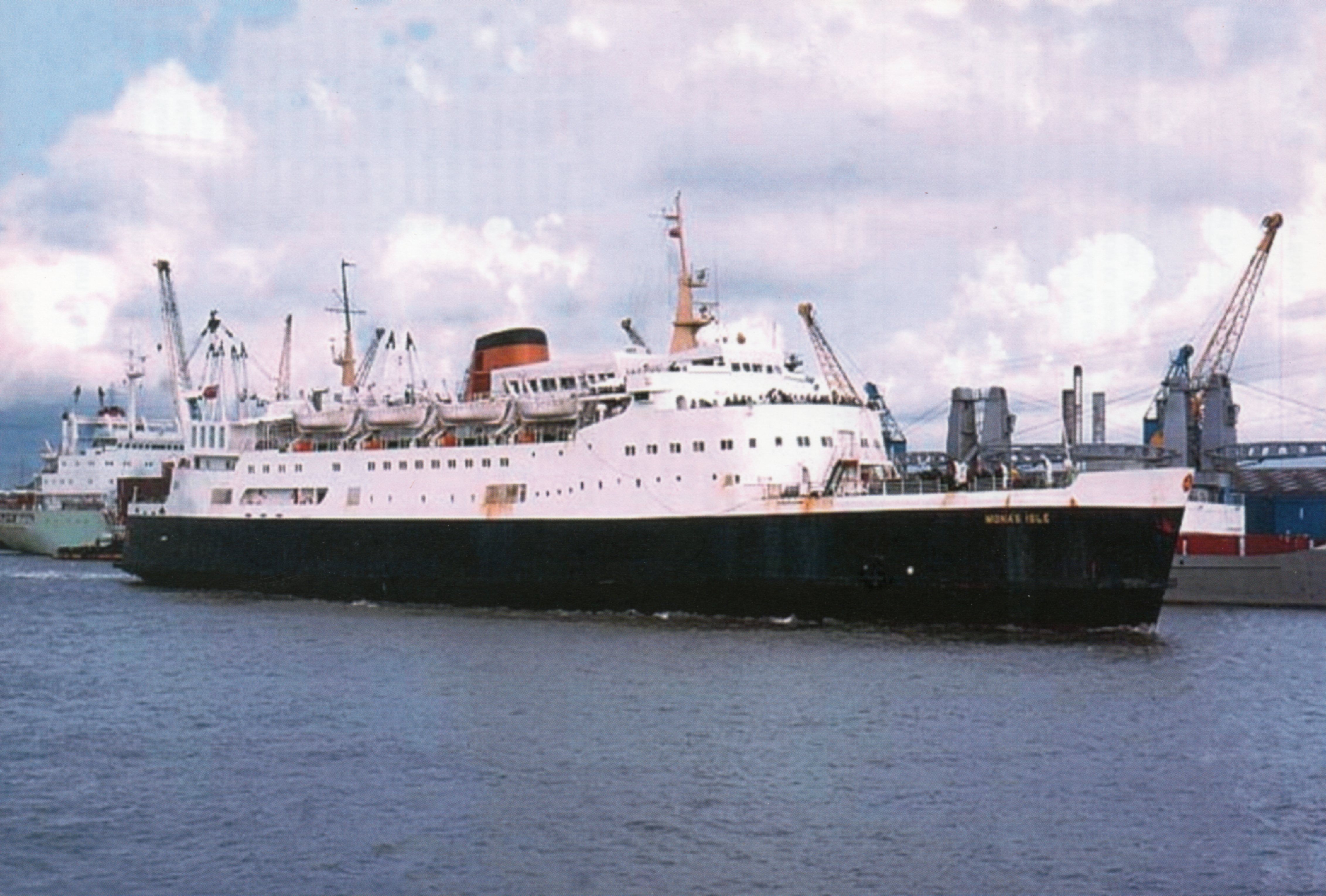
Monas
Isle 6 Had a
very brief history , she lasted only six months in service with the
Steam-Packet in 1985 : acknowledgements
To “Ships of Mann” magazine
for the photo 2013.
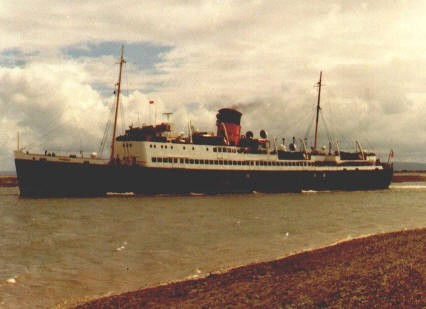
Above photo: acknowledgements to “ Ships of Mann” and I. of Man
Steam-Packet Co: for information
Tynwald
5 official # 165284
steel twin-screw steamer geared turbines built and engined at Cammell Laird
& Co. Ltd Birkenhead UK yard #
1184. Gross Tonnage 2487 Speed 21. 5 knots, overall length 105. 12m. Breadth
14.38 m. launched 24 July 1947 cost £461,859 maiden voyage 31 July 1947. Final
voyage 26 August 1974
Mona’s
Queen 4 official #
165283 steel twin-screw steamer geared turbines built and engined at Camel
Laird & Co. Ltd Birkenhead UK yard
# 1170. Gross Tonnage 2485 speed 21. 5 knots, overall length 105. 16m.
Breadth 14.38 m. launched 5 February 1946 cost £411,241 maiden voyage 26 June
1946. Final voyage 16 September 1961.
No photo
available in colour but reliable sources say . There were six sisters in all; King Orry,(1945) Mona's Queen, (1946)
Tynwald (1947), Snaefell (1948), Mona's Isle(1951) and Manxman (1955).
Reference the differences in window arrangements on the shelter deck. Tynwald
carried the big windows right forward while King Orry and Mona's Queen had four
small windows forward instead. However all six sisters had detailed
differences, even the Mona's Queen and King Orry. None of them were identical.
Ben-my–Chree 4
Acknowledgements below to Isle of Man
Steam-Packet Company for the “Ben-my-Chree (4) Photo:
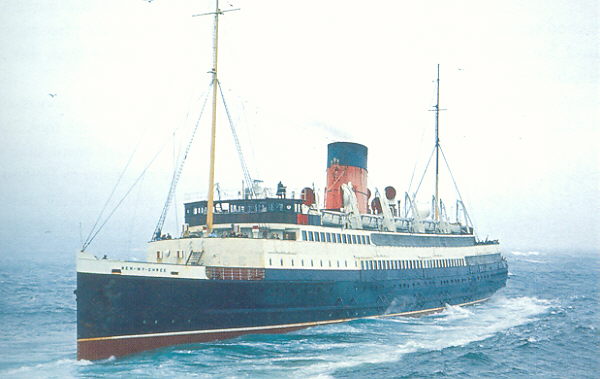
Ben-my-Chree
4 official # 145304
steel twin-screw steamer geared turbines built and engined at Cammell Laird
& Co. Ltd Birkenhead UK yard # 926.
Gross Tonnage 2586 speed 22. 5 knots, overall length 111.56m. Breadth 14.02 m.
launched 5 April 1927 cost £200.000 maiden voyage 29 June 1927. Final voyage 13
September 1965.
Lady of Mann (1) “The Flag-Ship “ of the fleet 1930 -1971
Acknowledgements to Isle of Man Steam Packet and
the "Sea Breezes" Magazine Vol 71 December #624 pages 982 - 987. Also
to Jane Coomer and the Manx Museum in 2001 for their kind donation of
information also Capt, B.M. Leek’s story
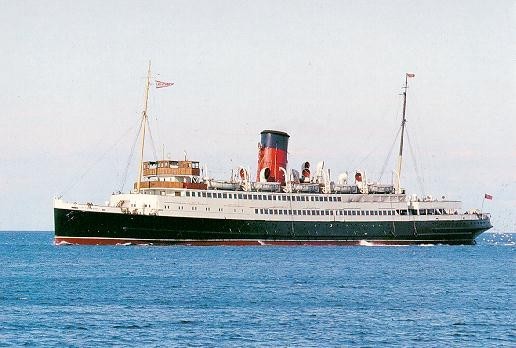
Particulars:
Tonnage: 2,029
gross, 1,258 net Signal letters:
LGCQ Livery Hull: white post 1930 and until
1939.
Length: 372
feet 9 inch OA, 360 feet BP Builders: Vickers- Armstrong Barrow, boot
top reddish brown.
Breadth:
50ft 2inch moulded Builders yard: #
660 Superstructure: white lifeboats white.
Draught:
13 ft 0.25 inch @ SLL Machinery: Geared
Turbines Ventilators: white.
Port of
registration: Douglas, Isle of Man. Engines output: 11,500
shp Masts white.
Official #
145307 Speed: 22.5 knots funnel: black cowled top
with red below carrying 2 black bands.
The Isle of Man Steam Packet Co’s "Lady of Mann' (1) of 1930 to 1971
By
Capt. B.M. Leek
The time of her building the ship was the largest owned by the
company and it was fitting that she was commissioned in time to commemorate
their centenary. In fact she was known as the Centenary ship, and with
affection by Islanders and travellers alike, as 'the Lady". The
ship was built by Vickers Armstrong Ltd, at their Barrow-in-Furness yard and
represented the latest development in fast home-trade passenger service.
She was, essentially, an elegant ship with an unbroken and
gently sheered shelter-deck, straight stem and elliptical stern, two long
superstructures, and a raked and cowled funnel, which was to be the hallmark of
the company’s ships until the coming of the side-loading car, ferry, Manx Maid 2. In 1962. She was the
first British ferry to be fitted with an Oertz rudder, closely resembling that
fitted to the Bremen and other multiple-screw vessels,
thus reducing the size of the designed rudder from 93.3 sq. ft to 83.6 sq. ft
while achieving a satisfactory improvement in steering efficiency. Also, to
improve steering when going astern, a bow rudder was fitted. The lines of the
twin shafting were totally enclosed by bossing. The
hull was built with five decks - designated boat-deck, promenade deck,
shelter-deck (weather deck), main and lower decks. of these, two decks, the
shelter and the main, were continuous throughout the ship. The lower deck,
however, was interrupted in the way of the engine-room. And the collision
bulkhead affected watertight subdivision was continued, weather-tight, up to
the shelter-deck level. Hydraulically operated watertight doors affected access
between the subdivisions, control valves and switches being positioned on the
bridge. An arrangement of hand-operated levers and audible alarms was also
provided to give warning that doors were about to be closed.
Over the greatest part of the ship's length, the bottom
construction was on the open floor system, but in the way of the engine-room,
and compartments immediately abaft it, a double bottom was included to allow
for the carriage of feed water and water ballast. The fore and after peaks were
arranged for the carriage of water ballast and a trimming tank was also
provided in the fore part of the vessel. Fresh water, for domestic use, was
carried in a tank between the propeller shafts. Two deep tanks were provided
immediately forward of the foremost boiler-room to provide capacity for
oil-fuel with a pipe-duct below.
There was no provision for cargo or the carriage of cars
since, of course, the company made allowance for the transport of such
vehicular traffic, as did exist on their specially designed small cargo
coasters.
Passenger accommodation was quite strictly divided,
according to the current practice of the railways, into first-class and
third-class provision. In general, first-class passengers were allocated
accommodation either amidships or forward while third-class passengers were
confined to the after part of the ship. Accordingly, sleeping accommodation was
provided in the three first-class saloons for 144 persons on the lower-deck,
forward, while there was provision for 90 third-class passengers in two saloons
at the after end of that deck. There were also six private cabins for
first-class passengers arranged on the promenade deck. There was additional
sleeping accommodation for 40 third-class passengers in the third-class dining
saloon at the after end of the main-deck, and an adjacent third-class private
ladies' sleeping saloon with sleeping berths for 32 passengers. The saloon
galley was located forward of the boiler casing on the main deck and a galley
for the crew was positioned abaft the boiler casing on the same deck. The
Stewards’ storeroom and a cabin for eight stewardesses forward of the
first-class dining saloon. The first-class lounge was located on the
shelter-deck forward and buffet and a special first-class private cabin were
arranged adjacent to it. The space abaft the Lounge was devoted to an enclosed
first-class promenade, large Beclawat windows being fitted on the sides. The
first-class smoke-room and bar were located abaft the engine casing. Beyond the
smoke-room to the after most extremity of the Superstructure was given over to
a third class Promenade space together
with a third-class entrance and buffet. At the forward end Of the Promenade deck a first-class ladies' saloon was located,
with berths for 52 passengers and, also, the first-
class-entrance. A tea bar and buffet
were provided at the after end and five private cabins were also provided. Promenading space was
allowed for on this deck, third-class passengers are being confined to the extension at the aft of the deck. The first-class
provision was also protected by side screens, lit by Baccarat windows, thus
ensuring adequate protection during foul weather crossings.
As in the case of the promenade space, on the shelter-deck, adequate portable sparred seats were provided.
Although the crossing is only short, great care was taken in
the planning and decoration of the passenger accommodation so as to provide
maximum comfort on the voyage. The first-class dining saloon was finished in
polished African walnut and ventilation and light were afforded by trunked
skylight and 14in hinged skylights. Polished hardwood tables and revolving
chairs, upholstered green leather and polished side- boards provided the main
items of furniture. As in the case of every public room, throughout the ship,
the ceiling was white and the beams were encased with white wooden moulding and
an electric Magicoal fire was provided. The lounge was particularly attractive,
being finished in mahogany panels relieved by ebony mouldings.
The furniture comprised of chintz fabric covered chairs and
similarly covered settees and occasional round tables. The tearoom was panelled
in apple-birch framed in gilt and polished sycamore, and lit by an ornamental
dome of coloured glass and large rectangular windows. The furniture of this
space included chintz-covered armchairs and settees and six small wooden
tables. The floor was laid with Korkoid tiling over, which were laid Axminster
carpet runners. An adjacent buffet with a serving hatch was fitted to provide
refreshments to passengers occupying the tearoom. The first-class ladies saloon
was panelled in Californian maple relieved by polished walnut. Settees provided
sleeping accommodation screened by curtains. A number of small tables and easy
chairs were also provided. Runners of Wilton carpet were laid over the Korkoid
tiling on the deck. Rectangular brass framed sliding windows provided light and
ventilation. The first-class smoke-room was panelled in fumed oak, and
comfortably furnished with upholstered settees, armchairs and small round
tables. A bar was incorporated with the smoke-room. The sleeping quarters for
first-class passengers included a number of private cabins, panelled in African
walnut and each fitted out with sofa-berths and hot and cold washing
facilities. The third-class passengers' accommodation was equally well founded,
if a little simpler and less comprehensive. All spaces were ventilated, both
naturally and by the punkah-louvre system of Thermotank Ltd. Indeed, all
passenger and crew spaces, and galley and storerooms were similarly ventilated.
The master was given a small suite of rooms, overlooking the
foredeck, in the forward house on the boat-deck. Two deck officers were
accommodated in cabins abaft the master and the radio officer was berthed on
the promenade deck. The engineer officers were accommodated on the main deck,
to. starboard of the engine casing. The purser was berthed to port of the
engine casing.
The chief steward and cooks were housed on the main deck
near the ship's galley and domestic departments, on the port and starboard
sides. Accommodation for seamen, firemen and stewards was provided at both ends
of the lower deck.
The ship's navigational equipment consisted of a range of
compasses, both standard and a vertical card steering compass and an emergency
compass on the poop. The wheelhouse, forward of the chartroom, also housed a
telegraph, ship's wheel and telemotor, an RDF device, and an echo-sounder and
Trident Log. 1 am not aware of any duplication of gear, except navigation
lights, to enable her to be steered stern foremost. Two telemotor steering
pedestals were also mounted on the bridge-wings to control the steam operated
bow rudder. A fully comprehensive inventory of life-saving equipment was
provided, in full compliance the statutory requirements Board of Trade for
vessels type, and for the service for which she was proposed. These included
ten Class 1A 27ft slung below semi-rotary Welin-Maclachlan davits and powered
by four electrically driven boat winches. Boat accommodation was supplemented
by a large number of life rafts and buoyant deck seats.
The ship was propelled by two sets of Parsons turbines
manufactured by the builders and designed to develop 11,500 ship. with power
astern being about 79% of that ahead. Condensers of the regerative type were
connected to the bottom valves of the low-pressure turbines. Steam was raised
by two single-ended and two double-ended boilers, both located forward of the
engine-room. The boilers were oil-fired working under forced draught of air
supplied by three fans. The fans were each of 26 h.p. 610 r.pm. and operated on
a voltage of 220 volts. Pumps, with the exception of the motor-driven
emergency bilge pump in one of the boiler rooms, were all steam powered.
The new ship was launched; on March 4, 1930; by Her Grace
the Duchess of Atholl. She left Barrow on June 12, 1930, adjusted compasses in
Morecambe Bay, and then proceeded to the Clyde for engine trials, testing the
efficiency of the stern and bow rudders on the way. Trials were undertaken on
June 13, 1930, on the Arran measured-mile course and a speed of 23 knots was
attained. The Lady of Mann initially joined the
Fleetwood-Douglas service, being opened for public inspection in Fleetwood and
then sailing on her maiden voyage on June 28, 1930. At the time of her trials
the "Lady's" hull was painted black, in accordance with I.O.M.S.P.
practice, but early in her career it was painted white, a colour which entirely
befitted her position as, firstly, the centenary ship, and, secondly, the
commodore ship of this important fleet. In this livery I have chosen to depict
her. In her first years she had a BOT certificate for 2,873 passengers.
In the summers of 1937 and 1938 the company boasted a fleet
of 18 steamships, the maximum number in its history. Each one, of course, was
fully occupied during the summer season but, in winter, the most important
members of the fleet were laid up on a care and maintenance basis. The Lady
of Mann herself usually spent the winter months at Barrow.
The first major event of the World War 2 came in June 1940
when, between May 28 and June 6, no less than eight ships belonging to the
IOMSP fleet were engaged in the evacuation of British troops from Dunkirk;
24,669 were rescued by the Isle of Man packets, including the 'Lady', which
undertook four passages from Dover and brought back as many as 4,262 troops.
Some 333,800 men, in total, were brought back to safety, in other words, one in
every 14 were transported back across the Channel on board Manx ships. A
fortnight later, the Lady of Mann took part in
Operation Ariel, lifting beleaguered British troops from Cherbourg, Brest and
Le Havre. During one voyage she made passage with 5,000 men on board. From
August 1940 until 1944, when she was converted into an LSI in preparation for
the Normandy invasion carrying six landing craft, she was engaged as a
Troop transport, often based in Lerwick in the Shetland
Islands. During the invasion she operated as Headquarters Ship for the 512th
Assault Flotilla, responsible for the landings on Juno Beach.
The "Lady" returned to Douglas to be given a civic
reception, proud and triumphant, on March 9, 1946. She was then partly
reconditioned by Cammel Lairds and in the Morpeth Dock before returning to full
service on June 14, 1946. The next major overhaul of the ship was undertaken in
the winter of 1958/59, which was carried out again by Cammel Lairds.
Car carriers began to appear in the fleet and diesel
propulsion was in the minds of the directorship by 1971. Doubtless there were
protests when it was decided that the 'Lady" had reached the stage when
she was no longer economic. Her final passenger sailing was from Ardrossan to
Douglas at 1400 on Sunday afternoon, August 14, 1971. A large crowd of
onlookers had gathered on the Point of Ayre, at the northernmost tip of the
Island, to witness this final homecoming of a much-loved ship. The Ramsey
Coastguard station signalled the event with a display of flares, and the
lighthouse keepers on Maughold Head saluted her with a mournful wailing of
their fog siren.
Two days later she left Douglas for the last time, witnessed
by thousands on the piers and promenades of the town, as she steamed away,
bound for a lay- up in Barrow. There she was put up for sale, with demolition
being the most likely option for a 41-year-old steamship. She was purchased for
breaking by Arnott Young of Daimuir and, on the last day of the year, she
arrived there under tow of the tug Wrestler. 11

http://www.manxman-som.fsnet.co.uk/
Classic Steam Packets of the
Past Part 2
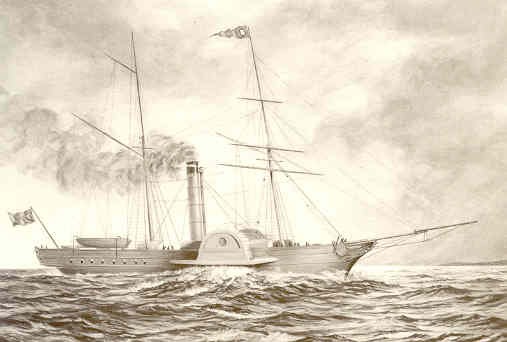
1. P. S. KING ORRY
1 Launched 1842 Gross Tonnage 433 Length 140' Speed 9.5
knots
The name "King
Orry “ was to become famous in the Steam Packet Company annals and "KING
ORRY”1" created her own place in the Company's history She was the
last wooden vessel built for the Company and also the only ship ever to be
built in Douglas for the Company Her average sailing times between Douglas and
Liverpool took 7 hours. She served the Steam Packet Co between 1849 until being
part exchanged as it were in 1858 against P.S. Douglas 1. Robert Napier &
Co's new vessel. This well known Glasgow steam engineering company in turn sold
her to the Greeks for trading throughout the Levant
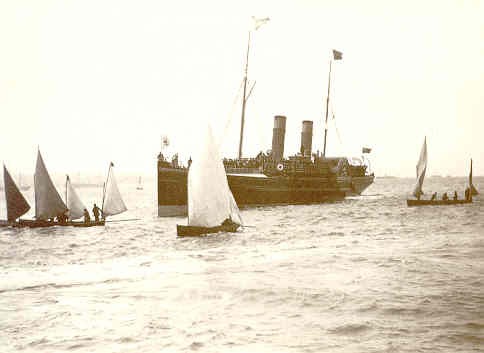
2. P.S. KING ORRY.2 Launched 1871 Gross Tonnage 809 Length 260' (later
lengthened to 290ft) Speed 17 knots.
The second bearer of the name to become legendary in
the Company's history, she created her own record by serving the Steam Packet
Company for 41 years. (The longest period any ship had served up to that time
Lengthened by 30' in 1888, and about this period was reboilered, this increased
her speed to 17 knots. During 1895 electric light was installed, a fine looking
ship, with counter stem and straight stem, fashionable at the time. In 1912 she
was broken up.
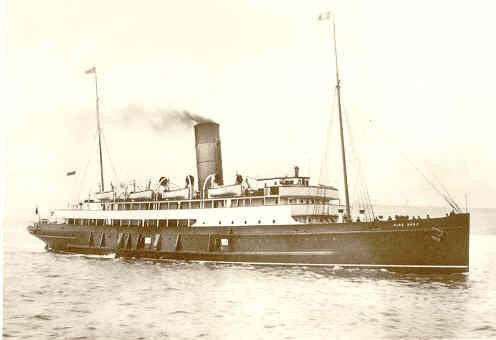
3. T.S.S. KlNG
ORRY 3. Launched 11-3-1913 Gross Tonnage 1876.72 Length (OA)
313ft Pass Acc 1st Class 884 3rd Class 716 Trial speed 20 knots The last ship
ordered by the Steam Packet Co before World War 1, she was requisitioned by the
Admiralty for duties as an armed boarding vessel. Operating from Scapa Flow she
intercepted and captured many ships carrying contraband to Germany Disguised as
a trader and renamed VIKING ORRY she patrolled the treacherous northern waters
off Norway. On November 21st 1918 she was awarded the singular honour by
Admiral Beatty, in recognition of the part played in the War by British Merchant ships, of leading
the capitulating German Grand Fleet into Scapa Flow Returning to the Steam
Packet Fleet, she remained on station until World War 2 this required this
veteran to return to hostilities as an armed boarding vessel in 1939. Sent in
at the beginning of the Dunkirk evacuation she saved many thousands of soldiers
within a few days, successfully surviving air attack. and coastal bombardment.
However, on May 29th 1940, an air attack damaged her severely and she sank,
becoming one of the four Company vessels lost at Dunkirk.
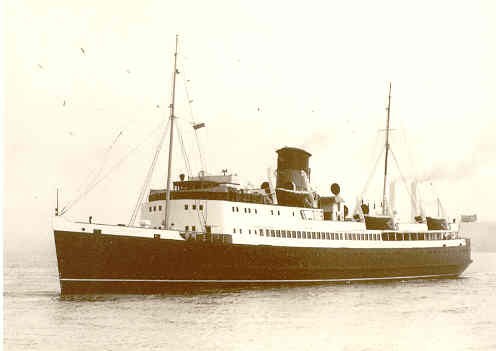
4. T.S.S. KING ORRY 4 .Launched 22-11-1945 Gross Tonnage 2484.63 Length
(OA) 345ft Pass Acc 1st Class 1079, 3rd Class 1144 Trial speed 21.6 knots. The
first of the post World War 2 ships built for the Steam Packet Co ,and was the
first of six ships built to this design, culminating in T.S.S.MANX MAN 2. KING
ORRY 4 was a well loved vessel and served the Steam Packet for 29 years,
sailing her last Company voyage in 1975. However, her name lives on for the
National Maritime Museum have bought parts of her machinery for display as
examples of the engineering used in the small boats of the "Dunkirk”
Armada"
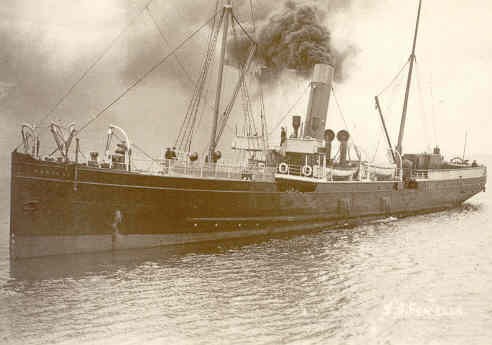
5.
S.S.FENELLA 1 Launched
1881 Gross Tonnage 564 Length 200ft Pass Acc 504 Speed 14 knots She was a very hard worked steamer, built as a cargo
ship, but with passenger accommodation for relief crossings during the winter.
Serving on all Steam Packet Company routes she was disposed of in 1929 after 48
years of service.
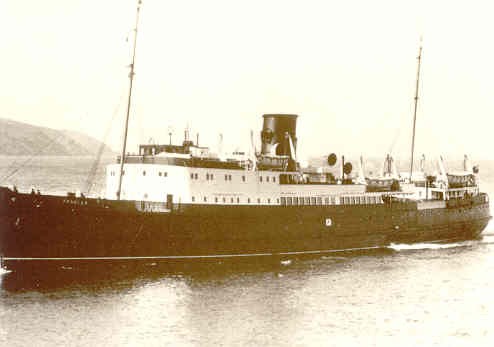
6. T.S.S.
FENELLA 2
Launched 16-12-1936 Gross Tonnage 2375.53 Length 314.6ft Trial speed 21.81
knots
Twin
to T.S.S.TYNWALD, FENELLA 2 was the shortest lived Steam Packet Company ship,
serving the fleet in the Irish Sea for just over 2.5 years, before being
requisitioned at the beginning of World War 2 by the Admiralty to act as a
personnel carrier. She transported troops between Newport, St Nazaire, Brest,
La Pallice, Quiberon Bay and Cherbourg but on her first mission to Dunkirk on
May 28th 1940. crewed by Steam Packet Co sailors. she came under heavy aerial
bombardment, whilst moored to the pier. Embarking troops. Seriously damaged by
the bombs. she was abandoned. later sinking. This disaster claimed the lives of
many of the Steam Packet crews.
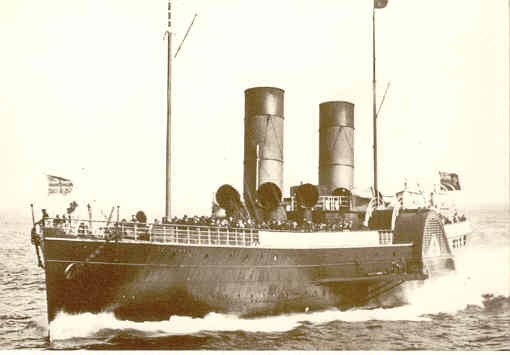
7. P.S. PRINCE OF WALES launched 14-4-1887 Gross Tonnage 1,547.2 Length (OA)
341.6ft' Pass, Acc Ist Class 1088. 3rd Class 458 Trial speed 24:25
knots. Bought by the Steam Packet Co on 23-11-1888, she was faster than her
sister ship P.S. QUEEN VICTORIA sailing in 1897 from the Rock Light, New
Brighton to Douglas Head in 2 hours 59 minutes. an average speed of 23.5 knots.
Renamed H.M.S. PRINCE EDWARD when requisitioned by the Admiralty
in 1915. She acted as a Boom Defence and Anti-Submarine vessel. Her war duties
took her as far away as the Eastern Meditenanean and she saw action in the
Gallipoli Campaign at one time accompanying another Steam Packet Co ship
SNAEFELL. Until eventually broken up 1920
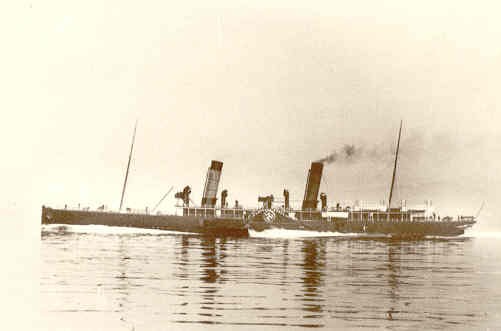
8. P.S.
EMPRESS QUEEN
launched 4-3-1897 Gross Tonnage 1,240. 23 Length (OA) 372ft. Pass Acc 1st Class 1509. 3rd Class 485 Trial
speed 21:75 knots. Named in honour of Queen Victoria’s jubilee-permission being
obtained through the Lieutenant Governor Lord Henniker P.S.EMPRESS QUEEN was
the largest and fastest paddle steamer built for cross. Channel service. She
was the first Steam Packet Company ship to be fitted with wireless and her
speed was such that she recorded a voyage from the Rock Light, New Brighton to
Douglas Head in 2 hours and 57 minutes. However she was to be the last paddle
steamer ordered from a shipyard by the Steam Packet Co She set a trend in
design for all. Subsequent Steam Packet Company ships by being fitted with a
bow rudder to increase manoeuvrability. In World War 1 being requisitioned by
the Admiralty she served as a troop ship ferrying soldiers between Southampton
and Le Havre This beautiful ship met her end on 12-1-1916 when she ran aground
in thick fog on the Bembridge Ledge, Isle of Wight, whilst carrying 1300 troops
returning to England on leave, attendant destroyers took off the troops safely
but an ensuing gale smashed the EMPRESS QUEEN beyond salvage.
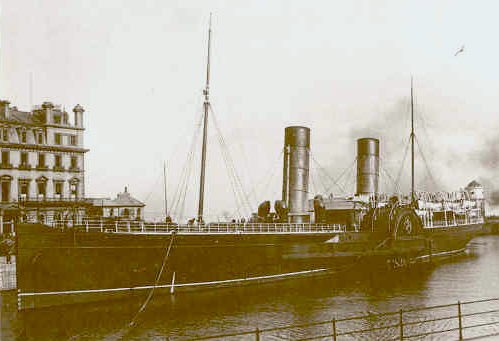
9.
P.S. MONA’S QUEEN 2.
Launched 1885 Gross Tonnage 1559 Length 320 ft -1 inch, Trial speed 19 knots.
She was the Steam Packet Company's answer to beat the rivalry of the Isle of
Man Liverpool & Manchester Company. As an indication of her speed she
sailed from Fleetwood to Douglas regularly in three hours approx. Chartered at
the outbreak of World War I by the Admiralty, she acted as a troopship ferrying
soldiers between Southampton and France. Her most spectacular war experience
occurred one night whilst carrying 1000 soldiers, when a German submarine was
spotted and staying on course in spite of a torpedo fired at her, the MONA 'S
QUEEN struck the U-boat’s conning tower with her port paddles and sank it,
after major repairs to her paddles caused by this incident, she continued
duties until the end of the war. She returned to the Steam Packet Company in
1920 and continued in service until 1929, being the last paddle ship to serve
in the Company's Fleet.
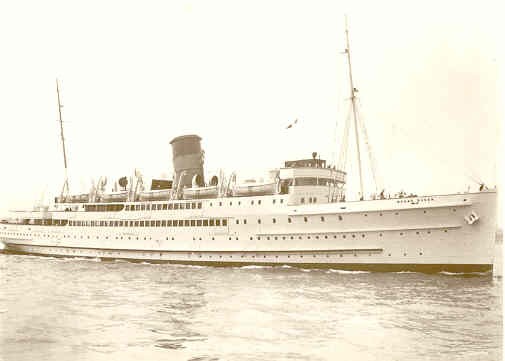
10. T.S.S.
MONA’S QUEEN 3. Launched
12-4-1934 Gross Tonnage 2755.88 Length (BP) 3376ft Pass Acc 1st Class 1413, 3rd
Class 1073 Trial speed 22.305 knots. Painted white with green boot topping on
her launching she was popular with passengers who appreciated her luxuriously
appointed interior Requisitioned for duties in World War II as a personnel
carrier she evacuated thousands of troops ( whilst crewed by Steam Packet
personnel ) from Calais, Boulougne, Ostend and Dunkirk in 1940, evading air
attacks and shore bombardments. She was the last merchant ship to leave Calais
having delivered 300 tons of explosives for the demolition of the docks before
the advancing Germans seized the port This gallant ship and crew met an
untimely end when returning to Dunkirk on the 29th May, 1940, being blown apart
by a bomb and sinking within 90 seconds claiming many lives of the Steam Packet
crew a photograph of her sinking is displayed in the Head Office of the Company
in Douglas.

11.
T.S.M.V. MONA’S QUEEN 5.
Launched 22-12-1971 Gross Tonnage 2998.34 tons Length (OA) 342. 7.5 feet Pass
Acc 1600 Trial speed 21.267 knots. In keeping with her historic name, MONA’S
QUEEN 5 created a number of "firsts" In the Company's annals She was
the first diesel passenger ship built for the Company, the first to be fitted
with variable pitch propellers, the first Steam Packet Co car ferries to sail
to Dublin and from Fleetwood. Fitted with twin rudders, bow thrusters,
stabilisers and bow rudder, her speed and manoeuvrability can be controlled
directly from the bridge by changing The pitch of the propellers She is a fast
and comfortable ship serving all the main ports of the Steam Packet Company, up
until 1990 she was then sold to a Manila shipping company and renamed Mary the Queen.
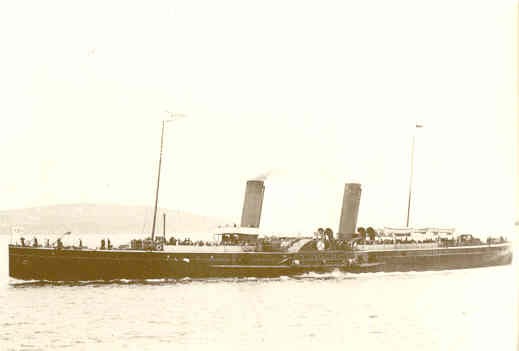
12. P.S. MONA 3 Launched 8-4-1889 Gross Tonnage 1212.9 Length (OA)
324.6 ft Pass Acc 1212 Trial speed 2075 knots. Originally built for the London
Chatham and Dover Railway Company and named P.S. CALAlS / DOUVRES, she was the first English cross channel
steamer To be installed with electric lighting. An example of her speed was as
such that a voyage across the English Channel took only 57 minutes (an average
speed of 2263 knots ) When the Steam Packet Co purchased her on 6-7-1903 and
renamed her, she was the last paddle steamer bought by the Company, and after 6
years on station was scrapped In 1909.
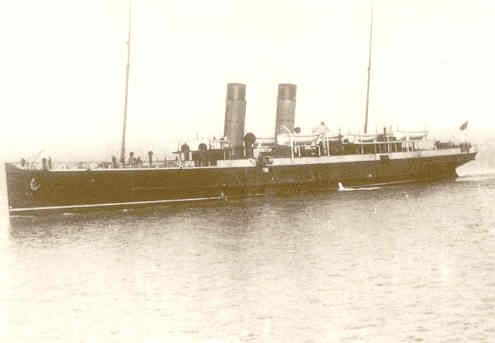
13. T.S. TYNWALD 3 Launched 11-5-1891 Gross Tonnage 936.72
Length (BP) 265 ft Pass Acc 1st Class 679, 3rd Class 225 Trial speed 1938
knots. It was the first time a shipyard-was specified to Install a Steam Packet
Company ship with electric lights, when she was ordered. During the First World
War she sailed the Douglas to Liverpool route a journey made hazardous by the
constant mining of the Mersey approaches by the Germans On 9-4 -1917 she was
involved in an exciting incident when on voyage from Douglas An American Liner
NEW YORK was torpedoed just outside the Mersey and TYNWALD racing to the scene
rescued all the passengers Her last voyage in Steam Packet Company colours was
on 23-8-1930, after which she was purchased by R A Colby Cubbon who Intended to
convert her into a private yacht. However at the outbreak of World War II the
Admiralty requisitioned her and she served as an accommodation ship to HMS EAGLET 2 at Birkenhead.
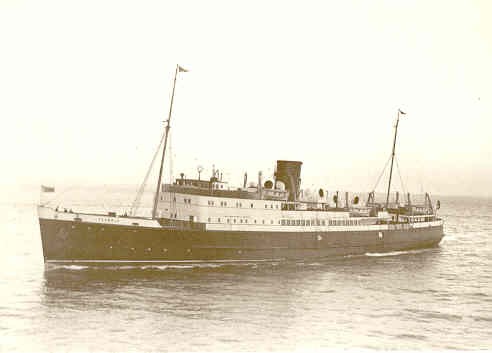
14. T.S.S. TYNWALD 4 Launched 16-12-1936 Gross
Tonnage 2375.53 Length (BP) 314.6ft. Pass Acc 1st Class 1086, 3rd Class 882
Trial speed 21.68 knots. Together with her sister ship T.S.S. FENELLA 2 she was the first Steam Packet Co
vessel to have a cruiser stem and was designed for the Winter Service routes.
As a personnel carrier after requisitioning, she attended the evacuation of
Dunkirk, Cherbourg and Le Havre ferrying over 8,000 troops to safety- more than
any other Steam Packet Co vessel. Converted to an anti-.aircraft ship and
commissioned H.M.S. TYNWALD.In 1941, she acted as convoy escort around England
until despatched to take part in Operation Torch, the Allied invasion of North
Africa, and the attack of Algiers in 1942. As an escort in the attack of Bougie
east of Algiers on 12-11-1942, whilst the naval force was being attacked from
the air, she struck a mine and sank
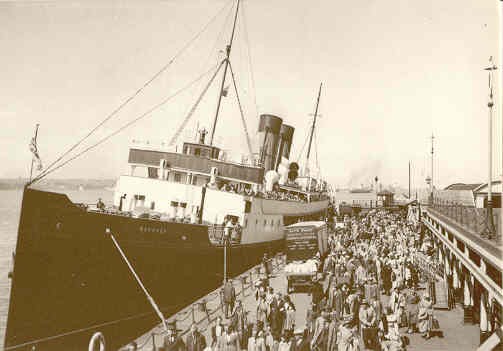
15. T.S.S. MANXMAN 1 Launched 15-6-1904 Gross Tonnage 2029.69 Length (BP) 334ft.
Pass Acc 1st Class 1155, 3rd Class 865. Built for the Midland Railway Company
she sailed on the Douglas - Heysham route before requisitioned by the Admiralty
on 17-4 –1916. Being converted to a sea plane carrier she contributed to naval
aviation by "flying off Sopwith Pup Fighters from her decks, although
these had to land on the sea, where, supported by flotation bags they awaited
to be hoisted on board again. The Steam Packet Co bought her when she was
released from war service converting her to an oil burner the first Steam
Packet Company ship to use oil fuel. In World War 2, again requisitioned, she
served as a personnel carrier evacuating troops from Dunkirk and North West
France. At Cherbourg fully ladened with troops and ammunition she only managed
to escape from the harbour with the aid of a destroyer despatched specially to
cover her evacuation, which fired upon a column of Panzers attacking along the
quayside. Commissioned as HMS CADACEUS
in 1941 she was converted to radio detection finding ship. At the end of the
War converted as a personnel carrier, she ferried troops and refugees from
Europe to England, finally being scrapped by I.O.M.S.P.Co In 1949
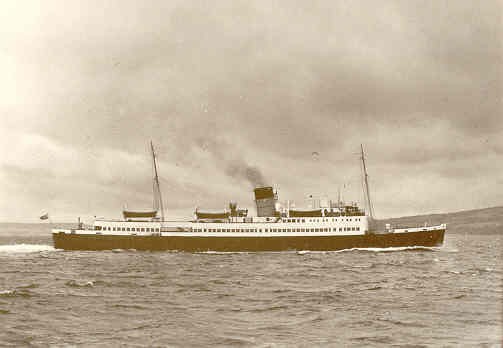
16. T.S.S. MANXMAN 2 Launched 8-2-1955 Gross Tonnage 2495.4. Length (OA) 344ft, Pass
Acc 1st Class 964, 3rd Class 1338 Trial speed 21.302 knots. The sixth and last
ship in the Class originating with the KING ORRY 4 differing only in her engine room. A comfortable and excellent
sea boat she still serves the Company though mostly on day excursions, except
for peak periods when she reinforces the Fleet on the major routes, this is
dated 1980, no longer in service.
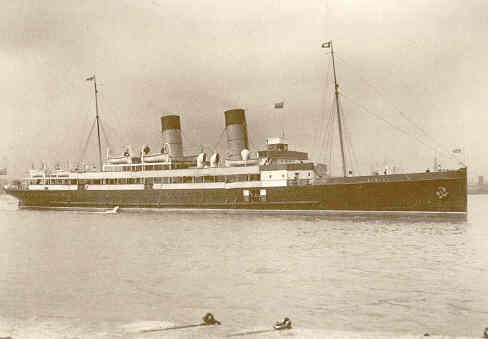
17. Tr.S.S. VIKING Launched 7-3-1905 Gross Tonnage 1956.76 Length (OA) 361ft, Pass. Acc 1st Class
976, 3rd Class 900 Trial speed 23.864knots. Built to compete with the Midland Railway Company's "MANXMAN" she was the first Steam Packet
Co ship to be turbine driven, and soon proved her speed by arriving in Douglas
from Fleetwood in 2 hours 22 minutes on 25-5-1907 (averaging 23.2 knots) also
sailing from Liverpool to Douglas in 3 hours. Converted to a seaplane carrier
by the Admiralty in World War 1 and renamed HMS VINDEX, she the first ship to
launch a wheeled undercarriage plane from her decks, presaging the advent of
the aircraft carrier. Attached to the Grand Fleet between 1915 and 1918 she
also saw active service in the Eastern Meditenanean.Between Wars she was on
station with the Steam Packet Co until, requisitioned for duties in World War
2. In which she evacuated retreating (troops from Le Havre and Cherbourg. On a
unique mission in 1940 she evacuated almost the entire child population of
Guernsey from St Peter Port. running the gauntlet of air attacks and landing
the children (1800 in all) at Weymouth. Released from War Service in 1945 she
sailed the Steam Packet Co routes until she steamed away to the breakers yard
on 16-8-1954. leaving a wonderful history of 49 years of service.
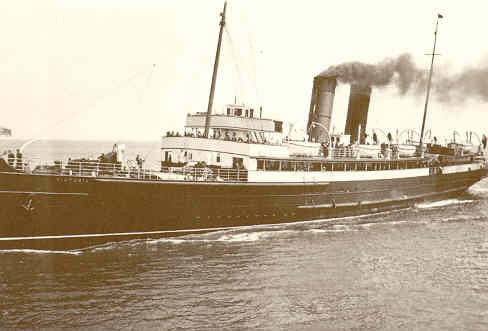
18. Tr.S.S. VICTORIA. Launched 27-2-1907 Gross Tonnage 1640.68 Length, (OA) 322ft
Pass Acc 1st Class 797, 3rd Class 843 Trial speed 22.575 knots. Built for the
South Eastern and Chatham Railway. she served as a Cross Channel ferry. On
January 11th 1919 she had the distinction of conveying the Imperial Delegation
to the Versailles Peace Conference. notable passengers on this voyage included
Lloyd George. the Canadian, Australian. New
Zealand and South African Prime Ministers and the Japanese Ambassador
etc. Purchased by the Steam Packet Co
in 1920 she remained on station until 1940 when she was mined in the River,
Mersey but not sunk. Repaired and requisitioned by the Admiralty she operated
as a target towing vessel until 1943 when she was used to train troops for the
imminent invasion of Europe and on D Day in 1944 landed British invasion forces
at Arromanches, and for a few days continued American forces on the Utah
beachhead. With the invasion progressing successfully. the VICTORIA reverted to
a personnel carrier ferrying supplies. and troops between the newly liberated
French ports and England Returning to the Steam Packet Co in 1947 she served
the Steam-Packet Company until being scrapped in 1957.
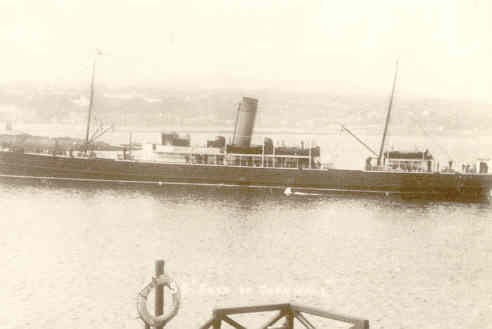
19. T.S.S.RUSHEN CASTLE Launched 23-4-1898
Gross Tonnage 1528 Length (BP) 371ft
Pass Acc 1st Class 924. 3rd Class 274 Trial speed 19.95 knots. Named
by her first owners THE DUKE OF CORNWALL.
She was used by the Lancashire & Yorkshire and the London &
North Western Railway Companies on the Fleetwood – Belfast route The Admiralty
requisitioned her for World War I duties as an armed boarding vessel. Bought by
the. Steam Packet Co on 11-5-1928 from the LMS Railway she was renamed RUSHEN
CASTLE and maintained the vital Douglas to Fleetwood route during World War 2.
She holds the dubious record of the longest voyage from Liverpool to Douglas.
During the war and journeying from Liverpool a storm struck Douglas Harbour and
the Captain was incorrectly advised by radio to head East (this should have
been West, meaning Peel as the destination harbour) Arriving in error at
Douglas and unable to berth in the Harbour the Captain was signalled to head for
Peel. However the storm veered by the time she arrived there and she was unable
to berth. Riding out the storm at sea until calmer conditions prevailed. she
eventually berthed at Peel 71 hours late after leaving Liverpool. She left the
Steam Packet Fleet for breaking up in January 1947.
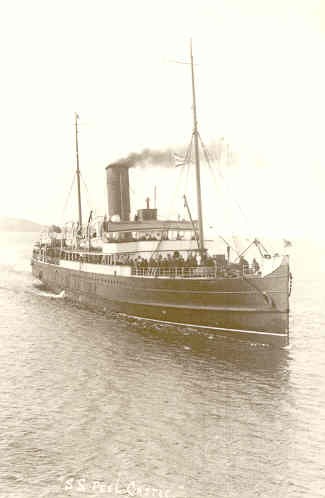
20. T.S.S. PEEL CASTLE. Launched 3-02-1894
Gross Tonnage I474.10 Length (OA) 3102ft Pass Acc 1st Class 509 3rd Class 820
Trial speed 19.06 knots. Originally named THE DUKE OF YORK. She was purchased from her owners
and renamed by the Steam Packet Co on 17-7-1912. Chartered by the Admiralty on
28-10-1914 she served in the Navy as an armed boarding auxiliary. Acting as a
guard ship deployed in a section of the Dover Patrol. She saw active service in
the Channel for 3 years, but after a serious fire she was refitted with depth
charge throwers and para vanes and despatched to patrol the Orkneys. Retuning
to the Steam Packet Fleet in 1919.she remained on station until l-l0-1938.
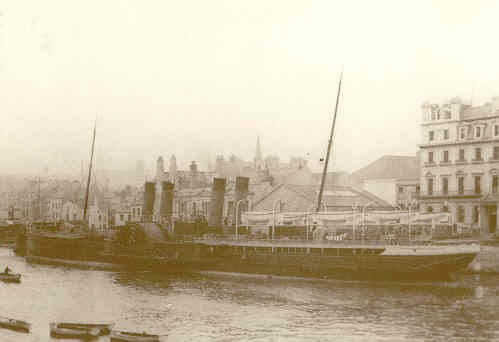
21. P.S. BEN-MY-CHREE 2. Launched 1875 Gross
Tonnage 1192 Length 310 ft Trial speed 14 knots. The largest ship ordered by
the Steam Packet Co at the time. she did not
meet the specified speed requirements laid down by the Company. She was
reboilered with extra funnels being added fore and aft making her the only
four-funnelled ship In the Company's history. She was in service for 31 years
finally being scrapped in 1908.
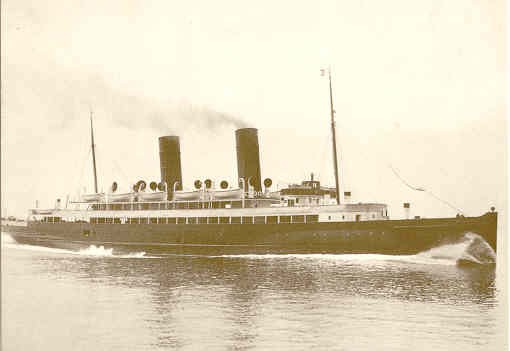
22. Tr.S.S. BEN-MY-CHREE 3 Launched 23-3-1908 Gross Tonnage
2550.28 Length (OA) 389ft Pass Acc 2549 Trial speed 26.64 knots.
The second turbine driven ship ordered by the Steam Packet Co. She was
even faster than Tr.S.S. VIKING and. She was the largest ship of her day. and
averaged sailings from Liverpool to Douglas in 2 hours. 53 minutes from pier to
pier. an average speed of 24.12 knots. When requisitioned by the Admiralty and
converted into a seaplane carrier. Tr.S.S. BEN-MY-CHREE. made her name in naval
aviation history when a plane launched from her decks torpedoed and sank a 5000
ton Turkish supply ship This was the first ever-successful aerial torpedo
attack. She saw a great deal of action in the Eastern Meditenanean. actively
Involved in the Gallipoli campaign. using her planes for bombing.
Reconnaissance and spotting for naval bombardment. On January 11th 1917
anchoring off the Island of Castellorizo, was occupied by the French. She was
within range of an unsuspected Turkish battery on the mainland, which sank her
by gunfire.
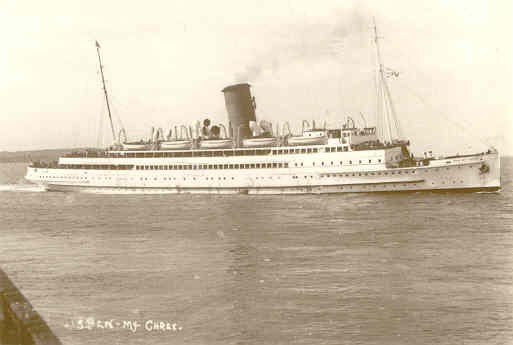
23.
T.S.S. BEN-MY-CHREE 4 Launched 5-4-1927 Gross Tonnage 2586.48 Length (OA)
3664ft Pass Acc First-Class 1642. 3rd Class 853 Trial speed off 22.535 knots
The first steamer built post World War I for the Steam Packet Co. she was
averaging over 20 knots on the Liverpool. Douglas sailings. She was painted
white with green boot topping for the 1932 season and was very popular with
passengers with her luxurious Interior. Requisitioned at the beginning of World
War 2. she attended the Dunkirk evacuation and saved over 4.000 troops before a
collision caused her to withdraw from this dramatic moment in history. She
sailed on transport duties between: Iceland and Britain until 1944 when she was
converted as a landing ship, for the forthcoming invasion of Europe. On D Day 6th
June 1944 she and her landing craft saw action off Omaha Beach. Landing the
crack American troops .She continued as a transport until 1946 when she
returned to service with the Steam Packet Fleet until disposed of in 1965- and
38 years of heroic and industrious service.
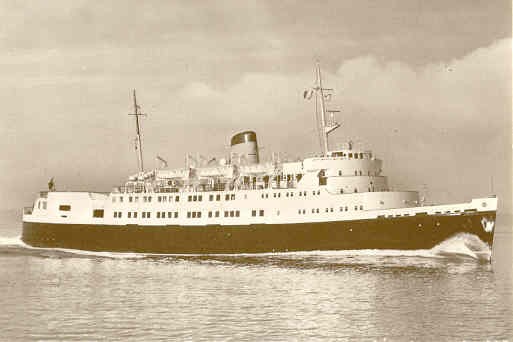
24.
T.S.S. BEN-MY- CHREE 5
Launched
10-12-1965 Gross Tonnage 2762.19 Length (OA) 329.8' Pass Acc 1400 Trial speed
22.086 knots.
Continuing the famous name, she was the second purpose built car ferry
being similar to T.S.S.MANXMAID 2 with
the same drive on drive off system. She was the last ship designed for
two-class passenger accommodation and in 1967 along with all the other Company
vessels was converted to one class. This two-tier passenger accommodation had
been the company practice for 136 years. BEN-MY-CHREE
5 operates on all the major 1980 routes of the company…. no longer in
service.
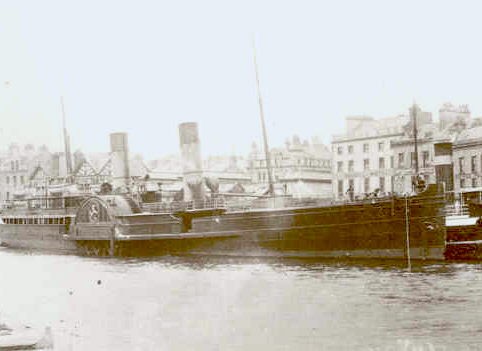
25.
P.S. SNAEFELL 2 Launched 1876 Gross Tonnage 849 Length 251ft.3" Speed 15 knots. An
iron paddle steamer, giving steady service for the Company for 38 years, she
was equipped with electric lights in 1895, quite an innovation at the time. She
was eventually sold in 1904.
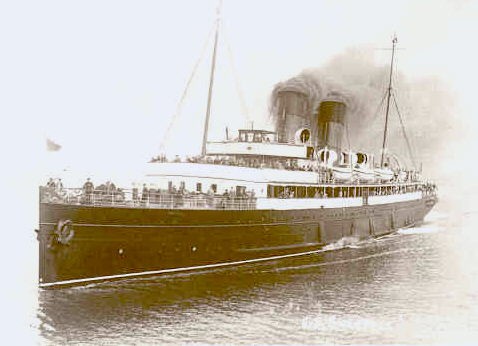
26. Tr.S.S SNAEFELL 4 Launched 10-3-1906 Gross
Tonnage 1712.68 Length (0A) 315ft Pass, Acc, 1st Class 1056, 3rd Class 643
Trial speed 22.576 knots. Named VIPER by her original owners and used on the
Ardrossan & Belfast route, she was requisitioned by the Admiralty. in World
War 1 as a troopship and ferried the British Expeditionary force from
Southampton to France. When purchased in 1920 by the Steam Packet Co and
renamed she served a variety of routes between wars. During World War 2 she
maintained the wartime routes between the Island and England (mainly Douglas /
Fleetwood being withdrawn from service in 1945.
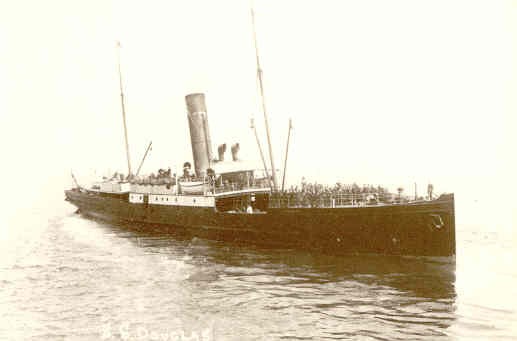
27. S.S.DOUGLAS 3 Launched
23-1-1889 Gross Tonnage 774.13 Length (BP) 340ft Pass Acc, 1st Class 362, 3rd
Class 144 Trial speed 16.52 knots. Named SS DORA by her original owners the
London & South West Railway Company, she plied the English Channel to the
Channel Islands When she was purchased by the Steam Packet Co on 26-7-1901 and
renamed, it was the first time (with the exclusion P.S. OF WALES and P.S.QUEEN
VICTORIA) that the Steam Packet Co bought a ship from another Company in stead
of ordering direct from a shipyard. The Steam-Packet Co were forced into this
action by the gap left in the Fleet through the loss of the PEVERIL in 1889.
During World War 1 she kept open the sea route between the Island and England.
Her unexpected demise occurred in the River Mersey when she rammed midships and
sank on 16-8-1923. All the crew and 15 passengers were taken off safely by the
ship that struck her.
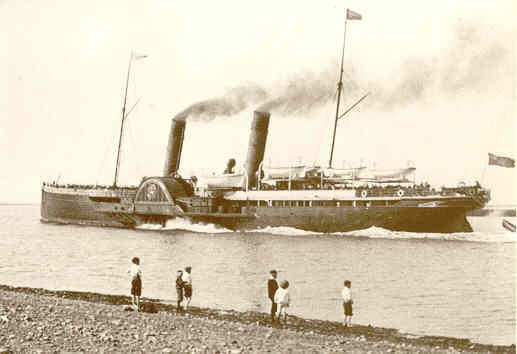
28. P.S. MONA’S ISLE 3. Launched 1882
Gross Tonnage 1564 Length 330ft.7" Pass Acc 1561 Speed 17knots.The largest
and most expensive steamer built at the time, she was a very fast ship and
sailed between Douglas and Liverpool in 3 hours 35 minutes. Purchased by the
Admiralty in 1915. she acted as a net laying and anti-submarine vessel. She
patrolled near Ireland and a large expanse of the Irish Sea on various
missions. She did not return to Company service after the First World War.
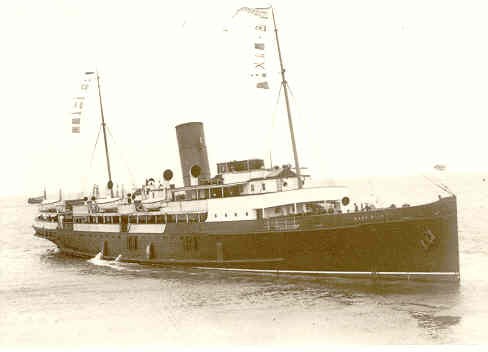
29. Tr.S.S.MANX MAID 1 Launched
25-5-1910 Gross Tonnage 1504.12 Length (OA) 298ft Pass, Acc, 1st Class 257 3rd
Class 643 Trial speed 2041 knots. Owned by the London & South Western
Railway Company. and named T.S.S. CEASAREA she was employed on the Southampton
to Channel Islands route. Commissioned in World War I as H.M.S. PYRAMUS, she
was an armed boarding vessel. After purchase by the I.of.Man. Steam-Packet Co
in 1923 and renamed MANX-MAID she sailed various routes until August 1939 when
she was requisitioned once again as an armed boarding vessel, helping in the
evacuation of France. Although commissioned as HMS PYRAMUS the Admiralty later
changed her name to H.M.S. BRUCE, employing her as a fleet air am towing
vessel. She returned to the Steam-Packet Fleet in 1945 and served the Company
until sold for scrap for scrap in 1950.
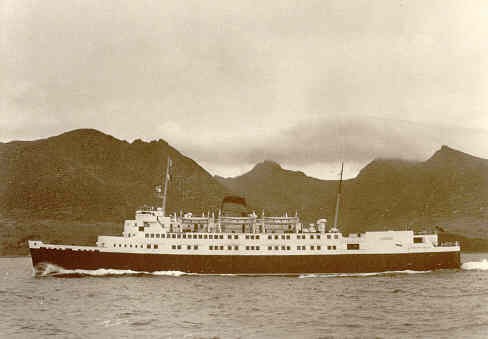
30. T.S.S.MANX MAID 2 Launched
23.1.1962 Gross Tonnage 2,723.99 Length (BP) 325' Pass Acc 1400 Trial speed
21.82 knots.
She was a milestone in the Company's
history, being the first purpose built car ferry (accommodating 9O cars and
also the first to be fitted with stabilisers. A unique spiral ramp loading
system with exits at various deck levels is employed to enable cars to be
driven on and off without hindrance from varying tidal levels in the ports used
by the Steam Packet Company She is now fitted with a bow thrusters a propeller
mounted side ways in the bow and is sailing on all the routes of the Steam
Packet dated 1980, no longer in service.
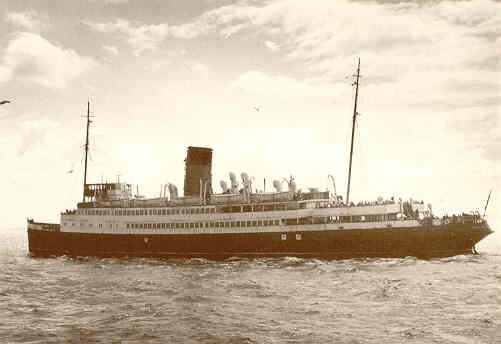
31. T.S.S.LADY OF MANN 1 Launched
4.3.1930 Gross Tonnage 3104.18 Length (OA) 372ft Pass, Acc 1st Class 1170, 3rd Class 1103 Trial speed 22.789 knots
Built in the Centenary Year of the Company, she was the
largest ship ordered by the Steam Packet Co. She was very popular with
passengers and very fast 22.79 knots on service. Painted white in 1930 like
BEN-MY-CHREE she also joined the "Armada" at Dunkirk being
requisitioned as a personnel carrier where her achievements were spectacular.
Her speed enabled her to evacuate over 4,000 soldiers whilst under air attack
and coastal bombardment. Days later she was one of the last three ships to
evacuate troops from Cherbourg, sailing out of the Harbour under an air attack.
She served as a personnel carrier until 1944 when she was converted for the D
Day Invasion, in which together with her landing crafts, saw action in the Juno
Beach Sector. Until the end of the War she ferried troops and refugees between
Europe and England, returning to the Steam Packet Co in 1946 and serving the
Company until being broken up in 1971.
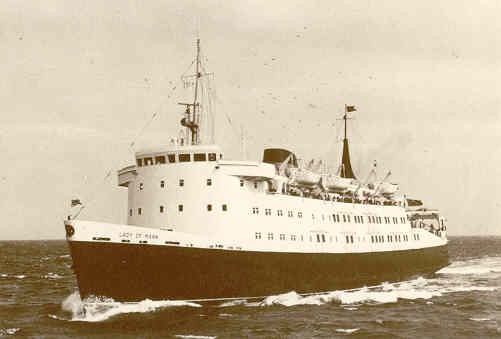
32. T.S.M.V. LADY OF MANN 2 Launched
4.12.1975 Gross Tonnage 2990.35 Length 322ft Pass, Acc 1600 Trial speed 21
knots The flagship of the Company's fleet, in the company's l 5Oth anniversary,
she is the fourth car ferry and fastest car ferry purpose built for the Steam
Packet Company, incorporating similar drive on drive off loading system as
previous car ferries. A sister ship to the T.S.M.V. MONA’S QUEEN 4 she has a
few differing features, enough to let the imitated know which one is coming in
to berth. She is the fastest vessel in the Company service, and in 1979 she
sailed from Fleetwood to Douglas (pier to pier} in 2 hours 39 minutes
Unfortunately the oil crises necessitates fuel conservation and prevents her
from sailing beyond her trial speeds which she could easily exceed. The
"Lady" as she is known locally. served the Company on all its major
routes, up until 2005. She left the Mersey 22 October 2005 for Pireaus in
Greece, she was renamed there Panagia Soumala.
Please note:
If the last four or more photo’s do not load, reselect Manx life line on home-page.
Acknowledgements to Adrian
Sweeny of “Ships of Mann” and
“A Pictorial History of the Isle of Man Steam-Packet Ships by Noel
Howarth dated 1980
Copyright Reserved © Brian E. P. Kneen email: bepkneen@kneen.com
Return to ….. Manx life line
Latest update is dated 5th January 2016
